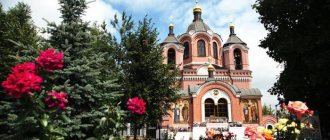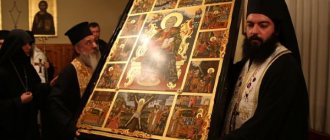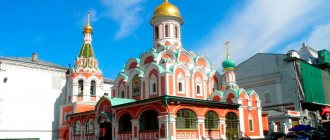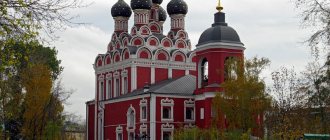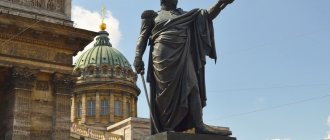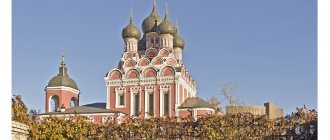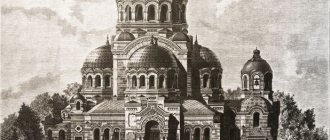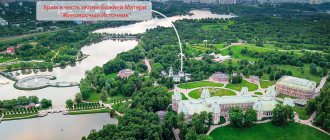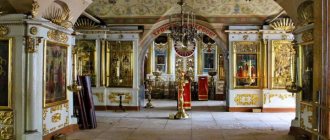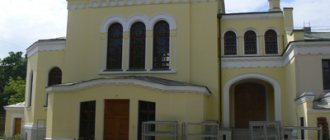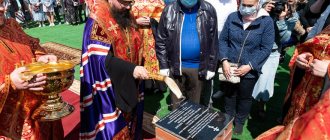Residents and guests of the city are recommended to visit the majestic Church of the Pochaev Icon of the Mother of God in Belgorod. Here you can see the main attraction - the image of St. Mary, and turn to her for help and support. This article will be devoted to a description of the church and its history.
The Church of the Pochaev Icon of the Mother of God in Belgorod is an active shrine where events are held to develop the spiritual life of people.
About the temple
Historical reference
The temporary temple was built as part of the “Program 200” and consecrated in 2015. On the site of the temporary temple, it is planned to erect an Orthodox temple complex in honor of the Pochaev Icon of the Mother of God.
Patronal holidays
August 5 – Icon of the Mother of God “Pochaevskaya”.
Schedule of services
— On holidays:
09:00 – Matins, Hours, Divine Liturgy.
— On the Great and Twelfth Holidays:
17:00 – Evening worship;
09:00 – Divine Liturgy.
— On Saturdays and Sundays:
17:00 – Evening worship;
09:00 – Divine Liturgy.
After the Divine Liturgy on Saturday, a funeral litany is celebrated.
After the Sunday Divine Liturgy, a water prayer service is performed.
Mir Russia Moscow Temple of the Pochaev Icon of the Mother of God in Chertanovo South (Moscow)
Community of the Church of the Pochaev Mother of God
exists since April 4, 2015, on the territory of the Southern Administrative District, Chertanovo South district of Moscow. The community's plans include the construction of a temple according to the project.
History of creation
The building is relatively new. The Temple of the Pochaev Icon of the Mother of God in Belgorod was created in 2010 under the name of the Pochaev Church by the architect A. I. Barannikov.
The current Orthodox Church of the Russian Orthodox Church of the Moscow Patriarchate is located on Yunosti Boulevard under building number 3-B.
The consecration of the stone building took place in 2012, this was done by Metropolitan John.
The Church of the Pochaev Icon of the Mother of God in Belgorod is a building that was created in gratitude for the help of the Mother of God. On the day when this icon is venerated, a significant event took place: the liberation of the city from the Germans. It was August 5, 1943.
Story
In March 2015, a temporary (wooden) church was erected in honor of the Pochaev Icon of the Mother of God.
On April 4, 2015, the dean of the church of the Don District, Archpriest Alexander Farkovets, performed a minor consecration of the temporary wooden church of the Pochaev Icon of the Mother of God in Chertanovo South, Moscow.
The dean was served by the person responsible for the construction, Priest Mikhail Negrya, the rector of the Church of the Prophet Daniel on Kantemirovskaya, Priest John Popadinets, and the cleric of the Church of St. Nicholas in Biryulyovo, Protodeacon Igor Simonov. The choir of the Church of the Prophet Daniel on Kantemirovskaya sang under the direction of Vasily Sysoev. About 60 people gathered for the consecration and the first Liturgy. 17 - Communion of the Holy Mysteries of Christ. The temporary temple is a type of basilica with a simple gable roof, practical, spacious, warm and bright.
Pochaev – House of the Blessed Virgin Mary
Estimated reading time: 3 minutes.
The Holy Dormition Pochaev Lavra received its name from the town of Pochaev, which is between the cities of Kremenets and Brody in the Ternopil region of Ukraine.
The monastery occupies a hill that rises above the surrounding area to a height of about 70 meters and is called Pochaevskaya Mountain. According to legend, even in ancient times, monks of the Kiev Pechersk Monastery, who fled from the Tatars, settled in the local caves, which were natural rock grottoes. These two monks devoted themselves to the feats of prayer, abstinence and remained in humility, covered by the grace of God.
Tradition also says that one day on the hill where the monks lived, the Mother of God appeared in a pillar of fire. The ancient Lavra tradition dates this event to 1240 or 1261. It is believed that after the prayer, one of the ascetics of Pochaev Mountain decided to climb to the top. Suddenly he saw the Most Holy Theotokos standing on a stone in a pillar of fire. The amazed old man immediately called his brother who lived with him. The shepherd John Bosoy and his youths, who were tending their flock under the mountain, also saw this. He hastened to climb the mountain and saw two monks there glorifying the Mother of God.
The Most Pure Virgin left the imprint of her right foot on the top of the hill, from which water began to ooze, endowed with the grace of healing. People flocked to the blessed source. Over time, with their donations, the monks built a stone church of the Assumption of the Blessed Virgin Mary on the southern slope of the hill. The imprint of the Foot of the Mother of God - the great shrine of Mount Pochaev - still contains healing water.
... In 1721, Uniate Catholics took possession of the monastery. It was a difficult time for the monastery, but even then the monastery chronicle recorded 539 miracles from the main shrine - the Pochaev Icon.
But access to another shrine - the relics of St. Job - was closed by the Uniates. However, after 20 years, the saint’s miracles forced them to admit believers to them.
During the reign of the Uniates, in the second half of the 18th century, for example, Uniate Count Nikolai Pototsky even became a benefactor of the Pochaev monastery. This happened thanks to a miraculous circumstance. Blaming his coachman for the mad horses overturning the carriage, the count took out a pistol to kill him. The coachman, turning to Pochaevskaya Mountain, raised his hands up and exclaimed:
“Mother of God, revealed in the Pochaevskaya icon, save me!”
Pototsky tried several times to fire the pistol, which never failed him, but the weapon misfired. The coachman remained alive.
The count immediately went to the miraculous icon and decided to devote himself and all his property to building the monastery. The Assumption Cathedral and the fraternal building were built with his funds.
In 1831, the Uniates were reunited with the Russian Orthodox Church. The relics of St. Job were again solemnly opened, and the Pochaev Monastery became a Lavra.
View of the surroundings of the Pochaev Lavra, photo www.flickr.com
Pochaev’s return to the fold of Orthodoxy was marked by the miraculous healing of the blind girl Anna Akimchukova, who came to worship the shrines with her seventy-year-old grandmother 200 miles from Kremenets-Podolsk.
In memory of these events, the Archbishop of Volyn, Holy Archimandrite of the Lavra Innocent (1832-1840) established a weekly reading of the cathedral akathist on Saturdays in front of the Pochaev Icon.
During the administration of the Lavra, Holy Archimandrite Agafangel, Archbishop of Volyn (1866-1876), a special chapel was built and consecrated on July 23, 1875 in the choir of the Holy Trinity Church in memory of the victory over the Turks.
...During the Great Patriotic War, Bandera’s followers shot Metropolitan of Kyiv and All Ukraine Alexy (Hromadsky), Bishop of Mukachevo and Tarnavsky Manuil and many priests near the Pochaev Lavra because they refused to go into schism and maintained unity with the Russian Orthodox Church.
...This is the history of the Holy Dormition Pochaev Lavra, the second most important in Ukraine. Even a cursory glance into the past is enough to see that this story is closely connected with the people who guarded the spiritual unity of historical Rus' and the Russian Orthodox Church. And now the monastery still remains the main stronghold of Orthodoxy in Western Ukraine.
Photo of the announcement www.flickr.com, ipernity.com/doc/df
Read also: Pochaev Icon of the Mother of God
Current state
The rector of the temple is priest Mikhail Negrea.
The temple is open daily from 9 am to 6 pm daily.
Divine services are held regularly according to the following schedule
:
- Wednesday
18:00 – Prayer service with akathist before the Pochaev Icon of the Mother of God;
- Friday
9:00 – Matins. Liturgy; 17:00 Vespers; prayer service; Memorial service.
- Saturday
9:00 – Matins. Liturgy. 17:00 – All-night vigil;
- Sunday
9:00 – Liturgy.
On the days of great holidays and great saints, services are performed according to the schedule.
POCHAEV LAVRA
POCHAYEV LAVRA (Holy Dormition Pochayiv Lavra), an Orthodox monastery with the status of stauropegic primate of the Ukrainian Orthodox Church (since 1997), located in the city of Pochaev (Ternopil region, Ukraine), in the south of Volyn.
Pochaev Icon of the Mother of God.
According to legend, the first monks on Pochaevskaya Mountain appeared after the defeat of Kyiv by Batu Khan in 1240. The first information about the monastery is given in the book of the Orthodox Archimandrite. Ioannikiy (Galjatovsky) (c. 1620–88) “The new sky, created with new stars” (1665), which reports that in 1261 near Pochaev the appearance of the Mother of God took place, from the imprint of Her foot on the rock a miraculous spring flowed (later known as “the healing foot of the Mother of God”), it is noted that a certain hermit monk lived in a cave near the rock. The legend about the appearance of the Mother of God to a shepherd and two monks near Pochaev, dating back to 1240, is mentioned in the Uniate (see Uniate) literary hagiographic. Sat. “Mount Pochaevskaya” (1742). The first mention of the Church of the Assumption of the Mother of God in Pochaev dates back to 1527 (letter of 1557 from the Polish king Sigismund II), but according to documents from 1570 we can conclude that this church was then not a monastery, but a parish.
The cenobitic monastery on Pochaevskaya Mountain was first documented in 1597. At the same time, the miraculous icon of the Mother of God was brought to the monastery, which later became Ch. shrine of the monastery, which received the name Pochaev Icon of the Mother of God. According to Sat. “Mount Pochaevskaya”, this icon was delivered to Pochaev in 1559 to the local landowner A.T. Erofeeva Goyskaya from Bulgaria. Among the first abbots of the monastery is Metropolitan. Sofia Neophyte (1607 - ca. 1616), who was in exile in Volyn, archimandrite. Petronius (Gulevich-Voyutinsky) (1616–17), St. Job of Pochaevsky (until 1651), under whom the monastery became a vast communal monastery with stone buildings and a printing house. In 1649, a stone church of the Holy Trinity was built over the “healing foot of the Mother of God”.
In 1712–14, in the Pochaev monastery among the brethren there was a struggle between supporters and opponents of the church union; in 1714 the monastery was officially annexed to the Uniate church. Nevertheless, even during the Uniate period there were many monks in the monastery who opposed Latinization. In 1773, with the blessing of Pope Clement XIV, Catholic. tradition, the Pochaev Icon of the Mother of God was crowned (official Catholic recognition of the miraculous icon).
The monastery returned to Orthodoxy on October 10 (22), 1831 (this was the reaction of the Russian authorities to the support of part of the Uniate monks of the Polish uprising of 1830–31), on November. 1833 received the status of a monastery. In 1833 the name of St. Job of Pochaevsky was included in the Council of Volyn saints, thanks to which P. l. became a major center of pilgrimage.
In 1921–39 P. l. as part of the Western Ukraine was located on the territory of Poland, was part of the Polish Orthodox Church, whose autocephaly the Russian Orthodox Church did not recognize at that time; since 1939 – on the territory of Ukraine and as part of the Russian Orthodox Church. In 1941–44 (during the German occupation of Ukraine) P. l. was part of the Ukrainian Autonomous Orthodox Church (in canonical unity with the Russian Orthodox Church). Since 1944 as part of the Russian Orthodox Church. During the period of persecution of the Church under N.S. Khrushchev, the brethren of P. l. and the believers undertook heroic actions. efforts against attempts to close the monastery. In con. 1980s - early 1990s P.l. tried to capture the Uniates and schismatics from the so-called. Kyiv Patriarchate.
Pochaev Lavra. On the left is the Assumption Cathedral, in the center is the bell tower, on the right is the Trinity Cathedral. Photo by S. Klimenko
Ch. temple of P. l. is oriented according to the conditions of the relief to the north primarily. Baroque Assumption Cathedral, built over the “healing foot of the Virgin Mary” in 1771–91 (architects G. Hoffmann and P. Polievsky). The c. standing at this place. The Holy Trinity was almost completely included in the cathedral building as a transverse transept (its eastern façade has been preserved). The miraculous Pochaev Icon of the Mother of God resides in the Assumption Cathedral. Under the cathedral there is a crypt (the oldest structure of P. L.) with the tomb of the monastery’s ktitor N. B. Pototsky, where a cave church was built in 1858. St. Anthony and Theodosius of Pechersk, next to it is a cave church. St. Job of Pochaev (rebuilt in 1774 and 1862) with the relics of St. Job and Amphilochius (in the world Yakov Varnavovich Golovatyuk; 1894–1971). Associated with the Assumption Cathedral are rectangular cell buildings (late 18th century), forming a closed composition with an interior. yard To the east wing of the buildings - c. Praises to the Blessed Virgin Mary (1862), in app. wing - refectory c. Saints Barbara and Prince. Olga (1888). In the ensemble P. l. also the bishop's house (1825), classic. gate building with c. Nativity of the Virgin Mary (1834–35), 4-tier bell tower (1861–69; the largest of 13 bells was cast in Moscow in 1886), Trinity Cathedral in neo-Russian style (1906–11, architect A. V. Shchusev; mosaic panel south The portal is made according to the drawing by N.K. Roerich), the well of St. Job.
Old necropolis of P. l. (not preserved) was located near the south. the foot of the Lavra Mountain, on the site of the later Lavra Garden, where until the middle. 19th century there was a cemetery church. St. Barbara (1774). The new necropolis was built in 1859 under the so-called. floor c. Nativity of Christ, built in the field where the coronation of the Pochaev Icon of the Mother of God took place in 1773. In 1872, 2 stone cells were equipped at this cemetery and the Nativity of the Virgin Mary cemetery monastery was founded (existed until 1944). From the turn of the 19th–20th centuries. Monastic burials take place in the cemetery at the parish church. St. Nikolai Pochaev.
Near P. l., according to documents from 1706–1760, there was a Holy Spiritual monastery (possibly founded in 1219 by the Athonite monk Methodius), towards the end. 18th century dilapidated, revived in 1900–01 as a registered building, closed in 1960, revived in 1990 (Central of the Descent of the Holy Spirit, 1902, architect L. I. Albertus). Until 1917 P. l. also had several other assigned deserts and farmsteads.
The healing power of the image
The icon helps Christian believers:
- heal illnesses;
- free yourself from evil spirits and addiction;
- strengthen faith and take the path of piety;
- get rid of sins;
- protect the house from ill-wishers.
In 1664, a case was recorded of the resurrection of a child, the son of a landowner who had died. But after my grandmother’s prayers before the holy face, the next morning I woke up alive.
Information for visitors
The schedule of the Church of the Pochaev Icon of the Mother of God in Belgorod is provided on the church website. It is indicated that services take place every day at 7:30 and 18:00, as well as custom prayer services. Their times:
- before morning service - on Mondays, Wednesdays and Fridays;
- parallel to the akathist at 17:00 - on Tuesdays and Thursdays;
- at 16:00 – on Saturdays.
For Sundays and holidays there is a special schedule:
- at 6:30 the beginning of the First Divine Liturgy;
- at 9:00 - the beginning of the Second Divine Liturgy;
- from 16:00 – the beginning of the prayer service at the icon.
Funeral services also take place every day after the morning service is over.
The rector of the Church of the Pochaev Icon of the Mother of God in Belgorod is Priest Alexey Taranov.
Description of the icon
Many miraculous events are associated with the face of the Mother of God depicted on the Pochaev Icon. She helped many believers who sought help and consolation.
For over fifty years, cases of healing, strengthening of health and the granting of faith to those who ask have been recorded.
The icon appeared in Russia thanks to Metropolitan Neophytos when he came to the Moscow Patriarch. This priest never set off on a journey without a holy image, which he considered blessing the long journey.
For the warm welcome in Moscow, the hierarch gave the icon to Anna Goiskaya, the hostess with whom he was staying. The icon was here for three decades. Eyewitnesses spoke of a wondrous glow that emanated from the holy face.
Soon the miracle of Anna's brother's epiphany occurred. He was blind from birth. And it became clear to the noblewoman that the icon should be given to the temple, where it could help not only her family, but also all sincerely praying Christians. So the face of the Mother of God was transferred to the Pochaev Monastery.
Today there are many reproductions of this sacred painting. The original is distinguished by a foot print, which is located at the bottom of the icon. This is a symbol of the footprint of the Virgin Mary, who became the Queen of Heaven.
